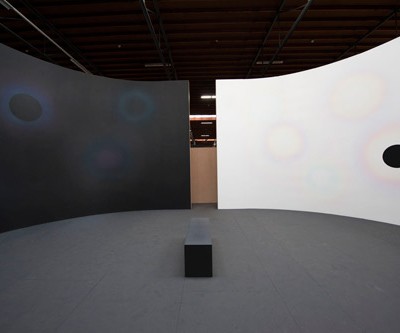roland schimmel
Roland Schimmel (Hooglanderveen, 1954) aims for a visual short circuit. He manipulates perception at the level of her subconscious reflexes. Afterimage and her effects, and therefore observation as a dynamic process, are central to his work. In his paintings, murals (installations) and computer animations, images are transformed into their complimentary counterpart. The works evoke confusion and reaction – afterimages being the consequence.
Roland Schimmel studied at the Academy voor Visual Arts in Arnhem, where he later taught. He exposed, among other places, in Rotterdam, Amsterdam, Porto, Berlin and New York.
Enervating powerlessness
The obvious thing would be to describe the work of Roland Schimmel from experience, my experience. Because that would be the easiest way of describing this overwhelming construction in black and white and every colour of the rainbow in between. I could write about how the work I move through manifests itself to me, how that semi-spheric deeply black wall glares at me, weighs down my limbs and constricts my breathing. How, when I turn around, the white feels like an exhilarating summer breeze on a hazy day. But if I did so extensively, I would not only ruin your experience, the question is what good it would do you. You are you, with your own experience. You need to encounter this work, which demands the cessation of thought, in your own particular way.
That is the beauty of Roland Schimmel’s new installation (far too frigid a word for the atmospheric space he, with the patience of a saint, erected and spray painted over layer by layer in the Noletloodsen): the democratic quality.
Each viewer is sucked into this space, which only initially appears to be the deepest of blacks and clear white. Keep looking, and discover that it exists (to paraphrase Italian writer Italo Calvino): the ability to have visions with your eyes wide open.
Since Roland Schimmel graduated from the art academy in Arnhem in 1978 with exclusively white paintings, he has been a seeker. Schimmel (1954) leaves The Netherlands, because he feels that his thinking is too limited here. First to Greece, then to an island in the Pacific, where he remains for a long time. Finally, he arrives in Indonesia, where a hindu master shows him that ‘everything is suffused with everything’.
The spiritual light art of American artist James Turrell — much admired by Schimmel — relates beautifully. With a single colour of light, Turrell manages to elevate a space to a meditative zone where all laws — including those appertaining contemporary art — are thrown overboard. Schimmel expands his search to Goethe’s Theory of Colours, with which the latter scientifically proved the existence of ‘afterimages’ in 1810. Alchemy, too, becomes a field of research. Mainly the symbolics of the pitch-black purity and the brilliantly bright white, covered in the rainbow coloured all-seeing ‘eyes’ of the peacock’s tail recur in Schimmel’s work.
The installations Schimmel has created over the past twenty years in public spaces, museums and other public buildings, increasingly play with the white and the black, with halos and afterimages that light up like the ‘eyes’ of a peacock’s tail. Rainbow colours emerge and vanish once more. The black knows many ways to manifest itself: from purple to near blue, grey and all-devouring black.
With his work, the artist explores the boundaries of where art meets meditation. And right on that boundary, the afterimages ‘live’ as projections of colours we’ve just seen in a different complementary state. Afterimages are as fleeting as thoughts, but they appear on the rhythm of the breath. Schimmel himself describes it thus: ‘Afterimages give you a feeling of enervating powerlessness.’
That enervating feeling of powerlessness begins with purely and simply looking at a white or a black wall. That is how the artist does it. That is how we do as he does.


